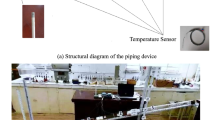Abstract
Coal mine belt fire develops very rapidly and is difficult to control. If not suppressed quickly, a belt fire could easily lead to airflow disorder and undermine the ventilation system. However, belt fire can be prevented effectively by establishing fire airflow control system. In this work, the 5th belt roadway of Kongzhuang coal mine was taken as the object of investigation, where geometrical models of this roadway were established firstly. Then, based on mathematical model of fire smoke flow, the CO volume fraction, smoke density distribution, air temperature and pollutant velocity vector in the roadway before and after taking airflow control measures were simulated by using Fluent software. It can be known from the simulation that with the normal ventilation status in 5th belt roadway, the countercurrent of smoke does not happen when a fire occurs; the roadway’s section is almost filled with CO at 10 m downstream from the fire source, and with air velocity getting stable gradually, the CO concentration reaches about 15 %. After taking airflow control measures, the effect range of temperature field which are harmful to the miners decreases from 69 m to 30 m; and the distance of the roadway fully filled with CO is 5 m farther than that before taking measures. Finally, according to the numerical simulation results and the actual condition of the belt roadway, the warning and automatic remote airflow control system with short-circuit method for the 5th belt roadway was designed to guarantee the safety production.
Similar content being viewed by others
References
WACHOWICZ J. Analysis of underground fires in Polish hard coal mines [J]. Journal of China University of Mining & Technology, 2008, 18(3): 332–336.
SINGH R V K. Spontaneous heating and fire in coal mines [J]. Procedia Engineering, 2013, 62: 78–90.
SINGH A K, SINGH R V K, SINGH M P, CHANDRA H, SHUKLA N K. Mine fire gas indices and their application to Indian underground coal mine fires [J]. International Journal of Coal Geology, 2007, 69(3): 192–204.
CHENG Wei-min, YAO Yu-jing, WU Li-rong, ZHOU Gang. Fluent-based numerical simulation of temperature and concentration during mine fire [J]. Coal Mine Safety, 2012, 43(2): 20–24. (in Chinese)
HU Ming-shun, PAN Dong-ming, CHEN Shen-en, DONG Shou-hua, LI Juan-juan. Numerical simulation for recognition of coalfield fire areas by Rayleigh waves [J]. International Journal of Mining Science and Technology, 2013, 23(1): 27–32.
SUN Bao-hong. Research and application of the local air-reversing system for centralized belt roadway [J]. Hebei Coal, 2011(2): 23–24. (in Chinese)
LIAO Yan-sheng. Revelation of mine belt conveyor simulation fire test [J]. Coal Mine Safety, 1992(11): 12–15. (in Chinese)
CHARLES D. Litton, INOKA Eranda Perera. Evaluation of criteria for the detection of fires in underground conveyor belt haulage ways [J]. Fire Safety Journal, 2012, 51: 110–119.
RAY S K, SINGH R P. Recent developments and practices to control fire in underground coal mines [J]. Fire Technology, 2007, 43(4): 285–300.
CHENG Wei-min, ZHANG Sheng-zhu, LIU Xiang-lai, REN Bao-hong, ZHU Lin. Research on disaster warning and air flow control system of mine belt roadway fire [J]. Mining Safety and Environmental Protection, 2009, 36(5): 18–20. (in Chinese)
WANG Kai, JIANG Shu-guang, ZHANG Wei-qing, WU Zheng-yan, SHAO Hao. Numerical simulation and application research of mine fire emergency rescue system [J]. Journal of China Coal Society, 2012, 37(5): 857–862. (in Chinese)
ZHOU Fu-bao, WANG De-ming. Computer simulation of mine fire of ventilation network [J]. Mental Mine, 2008(2): 115–117. (in Chinese)
WANG Hai-yan, ZHAO Hong-ze. Virtual reproduction method study of mine fire based on simulation [J]. China Coal, 2007, 37(7): 74–76. (in Chinese)
ZHOU Fu-bao. Rodway network fire characteristics and its application [D]. Xuzhou: China University of Mining Technology, 2003. (in Chinese)
HOU Gang, CHENG Wei-min, ZUO Qian-ming, BIE Hai-yan, ZHUGE Fu-min, BAO Qing-guo. Research of fuzzy comprehensive evaluation with dynamic variable weights for ability of reducing and preventing hazard in mining ventilation system [C]// LI Sheng-cai, WANG Ya-jun, AN Ying, SUN Xiu-yun, LI Xin. Proceedings of the 2008 International Symposium on Safety Science and Technology. Beijing: Science Press, 2008: 129–134.
GRATTAN K B, BAUM H R, REHM R G. Large eddy simulations of smoke movement [J]. Fire Safety Journal, 1998, 30(2): 161–178.
ASUSHI O, GRAHAM T A. Control of smoke flow in tunnel fires [J]. Fire Safety Journal, 1995, 25(4): 305–322.
U Y, BAKAR M Z A. Control of smoke flow in tunnel fires using longitudinal ventilation systems—A study of the critical velocity [J]. Fire Safety Journal, 2000, 35(4): 363–390.
UNSCH J P. Simple model for control of fire gases in a ventilated tunnel [J]. Fire Safety Journal, 2002, 37(1): 67–81.
UDIPTA B, PRAMIT R, SOUMALYA G, SUDIP M, MOHAMMAD S O. Wireless sensor network-based fire detection, alarming, monitoring and prevention system for Bord-and-Pillar coal mines [J]. The Journal of Systems and Software, 2012, 85(3): 571–581.
Author information
Authors and Affiliations
Corresponding author
Additional information
Foundation item: Project supported by Joint Innovative Center for Safe and Effective Mining Technology and Equipment of Coal Resources of Shandong Province, China; Project supported by Taishan Scholar Program of Shandong Province, China; Project(2014JQJH106) supported by Shandong University of Science and Technology Research Fund, China; Project(LAK2012-1) supported by Science and Technology Development Program of Safety Production of Shandong Province, China; Project(2012ZHTD06) supported by Science Research Innovative Group of College of Mining and Safety Engineering of Shandong University of Science and Technology, China
Rights and permissions
About this article
Cite this article
Zhou, G., Cheng, Wm., Zhang, R. et al. Numerical simulation and disaster prevention for catastrophic fire airflow of main air-intake belt roadway in coal mine—A case study. J. Cent. South Univ. 22, 2359–2368 (2015). https://doi.org/10.1007/s11771-015-2761-x
Received:
Accepted:
Published:
Issue Date:
DOI: https://doi.org/10.1007/s11771-015-2761-x




